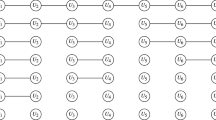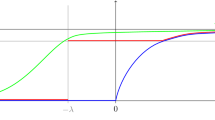Abstract
Consider \(G=SL_2(\mathbb {Z})/\{\pm I\}\) acting on the complex upper half plane H by \(h_M(z)=\frac{az\,+\,b}{cz\,+\,d}\) for \(M \in G\). Let \(D=\{z \in H: |z|\ge 1, |\mathfrak {R}(z)|\le 1/2\}\). We consider the set \({\mathcal {E}} \subset G\) with the nine elements M, different from the identity, such that \(\mathrm{tr\,}(MM^T)\le 3\). We equip the tiling of H defined by \(\mathbb {D}=\{h_M(D){:}\, M \in G\}\) with a graph structure where the neighbours are defined by \(h_M(D) \cap h_{M'}(D) \ne \emptyset \), equivalently \(M^{-1}M' \in {\mathcal {E}}\). The present paper studies several Markov chains related to the above structure. We show that the simple random walk on the above graph converges a.s. to a point X of the real line with the same distribution of \(S_2 W^{S_1}\), where \(S_1,S_2,W\) are independent with \(\Pr (S_i=\pm 1)=1/2\) and where W is valued in (0, 1) with distribution \(\Pr (W<w)=\mathbf ? (w)\). Here \(\mathbf ? \) is the Minkowski function. If \(K_1, K_2, \ldots \) are i.i.d with distribution \(\Pr (K_i=n)= 1/2^n\) for \(n=1,2,\ldots \), then \(W= \frac{1}{K_1+\frac{1}{K_2+\ldots }}\): this known result (Isola in Appl Math 5:1067–1090, 2014) is derived again here.
Similar content being viewed by others
References
Bougerol, P., Lacroix, J.: Products of Random Matrices with Applications to Schrodinger Operators. Birkhauser, Boston (1985)
Benoist, Y., Quint, J.F.: Random Walks on Reductive Groups. Springer, Berlin (2016)
Chamayou, J.-F., Letac, G.: Explicit stationary distributions for composition of random functions and products of random matrices. J. Theor. Probab. 4, 3–36 (1991)
Chassaing, P., Letac, G., Mora, M.: ’Brocot sequences and random walks in \(SL(2,{\mathbb{R}})\). Springer Lect. Notes Prob. Groups IX 1084, 37–50 (1984)
Denjoy, A.: Sur une fonction réelle de Minkowski. J. Math. Pures Appl. Sér. 17 IX, 105–151 (1938)
Isola, S.: Continued fractions and dynamics. Appl. Math. 5, 1067–1090 (2014)
Jordan, T., Sahlsten, T.: Fourier transforms of Gibbs measures for the Gauss map. Math. Ann. 364, 983–1023 (2016)
Minkowski, H.: Zur geometrie der Zahlen. Verhandlungen des III internationalen Mathematiker-Kongress in Heidelberg, Berlin (1904)
Olds, C.D.: Continued Fractions. The Mathematical Association of America, Washington, DC (1963)
Salem, R.: On some singular monotonic functions which are strictly increasing. Trans. Am. Math. Soc. 53, 427–439 (1943)
Serre, J.-P.: Cours d’arithmétique’, deuxième édition revue et corrigée. Presses Univ. de France, Paris (1977)
Viader, P., Paradis, J., Bibiloni, L.: A new light on Minkowski’s ?(x) function. J. Number Theory 73, 212–227 (1998)
Acknowledgements
We are grateful to an anonymous referee for useful comments and references. G.L. thanks Sapienza Università di Roma for its generous support during the preparation of this paper.
Author information
Authors and Affiliations
Corresponding author
Rights and permissions
About this article
Cite this article
Letac, G., Piccioni, M. Random Walks in the Hyperbolic Plane and the Minkowski Question Mark Function. J Theor Probab 31, 2376–2389 (2018). https://doi.org/10.1007/s10959-017-0783-z
Received:
Revised:
Published:
Issue Date:
DOI: https://doi.org/10.1007/s10959-017-0783-z




